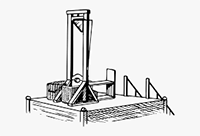The Guillotine
The guillotine was the weapon of choice for executions during the Reign of Terror in the late 18th Century in France. Thousands of so-called enemies of state were put to death by way of the guillotine. That is perhaps the most famous reference to the guillotine in the pages of history, but the device itself, and the idea behind, it, are much older. 
For about as long as people have had edged weapons, they have been killing other people by cutting off their heads. This was true in West and East for a great many years. Stories from medieval times tell of devices doing the work, so that a person's effort wasn't needed, except to operate the machine. Both the Halifax Gibbet and the Maiden in Scotland date to medieval times, the former to the 13th Century and the latter to the 16th Century. Other civilizations using such devices during medieval times included Flanders, Germany, Italy, and Persia. The guillotine as constructed in Revolution-era France consisted of a wooden frame tied to the top of which was a heavy angled blade. A rope connected to the blade could raise or lower it. Antoine Louis, who was physician to King Louis XVI, built a prototype. He had help from Tobias Schmidt, a German engineer and maker of harpsichords. For a time, the device was called a louisette, after The first execution by guillotine was of Nicolas Pelletier, a thief, on April 25, 1792. A great many more guillotine executions followed during the next two years. A short list of famous people who were put to death in this way includes the following:
The guillotine was the prime instrument of control during the Reign of Terror, which is generally regarded to have ended with the death of its most lethal proponent, Maximilien Robespierre. He was killed, of course, by the guillotine. The guillotine sat in a public square. Executions were spectacles, often attended by large crowds, who cheered the activities on display. During the Reign of Terror, in just a 13-month period, the guillotine claimed more than 17,000 lives. France kept the guillotine as an official means of execution long after the demand for it waned. The last public use of the guillotine in France was in 1939. The last private execution by guillotine occurred in 1977. The country outlawed the death penalty in 1981.
|
|
Social Studies for Kids
copyright 2002–2025
David White



 Louis, the king's doctor. The more well-known name came from another doctor, Joseph-Ignace Guillotin (right), who in October 1789 proposed to the
Louis, the king's doctor. The more well-known name came from another doctor, Joseph-Ignace Guillotin (right), who in October 1789 proposed to the 
